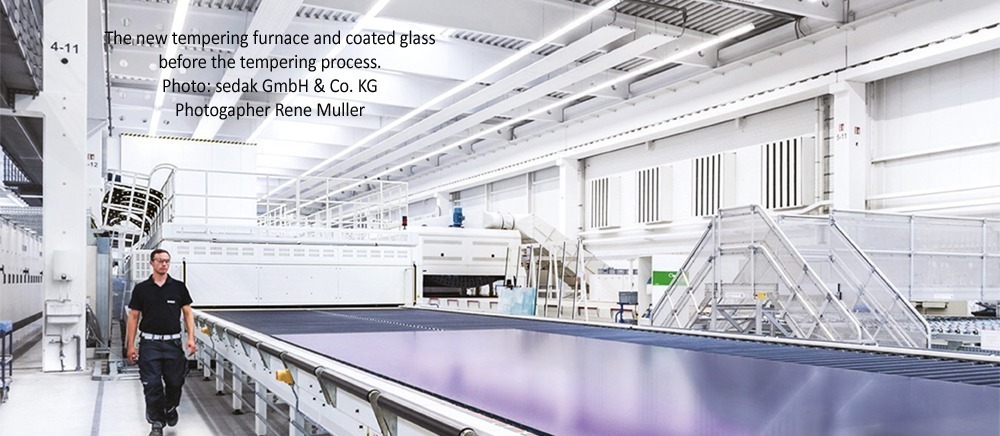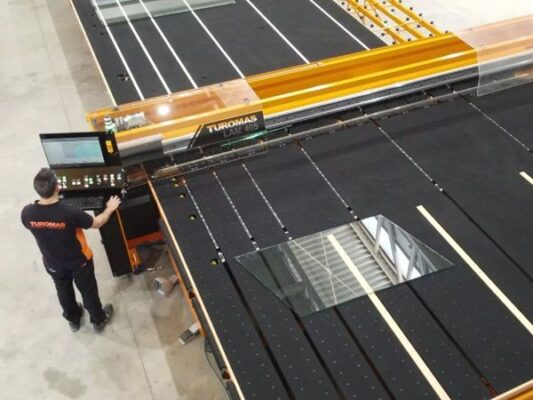Tempering Coated Glass of Up To 16.5 Metre Now
When tempering glass areas of up to 50 square metres, sedak’s new tempering furnace comes into play. It processes glass with the maximum dimensions of 3.2 m x 16.5 m into fully tempered or heat strengthened glass

With this second furnace, the specialist for oversize glass not only doubles its tempering capacities but also enlarges its entire production to a new maximum length of 16.5 m. Thanks to innovative technology and sedak’s know-how, the new tempering furnace can toughen coated glass in oversize dimensions which means an enormous time and cost benefit. “Our new furnace allows us to expand the status quo and to realize a leap in technology,” says Ulrich Theisen, General Manager and Sales Director of sedak. As modern façade glass has to fulfill ever higher demands on structural physics, coatings for solar and thermal protection become more and more important. Additionally, the trend to very large glass formats persists although the handling and the logistics of them are particularly complex. Therefore, sedak permanently improves its production processes regarding technology and efficiency. A result of that development is the new tempering furnace. It extends the maximum length from 15 m to 16.5 m and optimizes the production process. Coated glass can now be tempered also in the maximum dimensions.
Challenge: Coated Glass
When tempering in the furnace, the glass has to be heated on both sides evenly. A coating has a major impact on that process. Especially low-e and solar control coatings are difficult to be tempered because they reflect the heat. Hence, the glass heats faster on the non-coated (lower) side and, with the generally used technology, the edges would bend upwards. That effect increases with the size of the glass. Similarly, the larger the glass, the more probable are anisotropies, roller waves, or color changes. Further damages of the coating can appear due to non-regulated heat distribution which could additionally burn the coating, change its color, or cause cracks. “To achieve the perfect result, it is essential to regulate and control the heat distribution in the furnace, and to adjust it to the specific profile of the glass pane,” explains Theisen. What first sounded simple is in fact a highly complex
firing process that requires, besides a high-performance furnace, operating personnel that are very experienced with the raw material glass.
Leap in firing technology
The specification sheet for the new furnace arose from the praxis. For a project in St. Petersburg, sedak
had to supply 16.5 m long glass fins. However, the existing tempering line was designed to process glass only up to 15 m. That was the cornerstone of purchasing a new tempering furnace. Moreover, the previous firing technology was supposed to be improved. “Our ten-year experience of tempering oversize glass was included in the development,“ says Theisen. “It was about improving the regulation and to increase the overall performance.” Tempering coated glass up to 16.5 m is a technical and, in the end, also an economical milestone. With a common furnace, that would not have been possible. The new furnace is a so-called convection furnace that allows for a quick and exact heat regulation. Also the quenching station, in which the tempered glass is cooled, received an upgrade because coated glass reacts faster to changing air conditions. Now, the operators can influence the production process in that part of the machine precisely.
Knowledge is not scalable
To temper coated glass is nothing new. However, the knowledge and the technology cannot be simply transferred from standard formats to oversize dimensions. With increase of every metre in glass, the tempering process becomes more difficult. “Each defect in that step cannot be corrected and worsens during the following production process,” says Theisen. Deviations regarding flatness or shape turn the glass quickly into reject. Hence, it is worth it to put great effort into a perfect production because the result is convincing: extremely flat high performance glass fabricated accurately to a millimetre; glass that is quickly processed into the desired functional glass units. This is the perfect interaction of modern machinery and glass experts. “Such a precise production would not be possible without the know-how of our operators. They know when they have to adjust the prevailing machine settings.”
3 Questions to Ulrich Theisen
Which were the decisive reasons for planning a furnace that can temper oversize, coated glass?
Glass bigger than 9 metres is growing in popularity. Therefore, we first increased our delivery capacity. Since we are now able to temper coated glass of that size, we have also reached the goal to produce such glass quicker and in high quality. What was a special challenge? The demands on façade glass and its structural physics have been rising on and on. To fulfill those requirements, the coatings have become ever more complex. That applies to solar control as well as low-e coatings. However, it’s especially those coatings that have an extremely high impact on the result in the furnace. There is simply a difference between a triple silver coating and a nickelchrome coating that goes through the furnace. So, we have to be able to adjust the machine to the respective special feature of the glass; and the operator has to know how the glass and the coating react to the firing process. Our experts are very experienced in handling the tempering furnace. By the way, there are some coatings that still cannot be tempered. In that cases, the production works in reverse order and the glass is first coated and then tempered. And how did you solve that challenge? The new furnace works on a convective principal. Thus, it is possible to heat it evenly but also to adjust single sections. Improved heating circuits allow us now to balance the heating considerably faster and more precisely. We also had a close cooperation with the furnace fabricator. Not only our tenyear experience in tempering glass but also our partner’s experience in constructing furnaces influenced the development.
About the company
sedak, the glass manufacturer in Gersthofen, Germany, was founded in 2007. The company and its 150 employees have developed into the world’s technology and innovation leader for large insulating and safety glass. With a 10-year experience of manufacturing oversize glass and after having increased the level of automation continuously, sedak is regarded as a specialist in this know-how intensive segment. The core capabilities are the lamination of glass, edging, and the company’s special knowledge of producing glass components with additional functional and decorative elements. sedak’s production has been optimized for extraordinary glass sizes and weights.












I have checked your website and i have found some duplicate content, that’s why you don’t
rank high in google’s search results, but there is a tool that can help you to create 100% unique content, search for:
Boorfe’s tips unlimited content
Hey very nice bⅼog!